Jeremy H. M. Wong
Incorporating Contextual Paralinguistic Understanding in Large Speech-Language Models
Aug 10, 2025Abstract:Current large speech language models (Speech-LLMs) often exhibit limitations in empathetic reasoning, primarily due to the absence of training datasets that integrate both contextual content and paralinguistic cues. In this work, we propose two approaches to incorporate contextual paralinguistic information into model training: (1) an explicit method that provides paralinguistic metadata (e.g., emotion annotations) directly to the LLM, and (2) an implicit method that automatically generates novel training question-answer (QA) pairs using both categorical and dimensional emotion annotations alongside speech transcriptions. Our implicit method boosts performance (LLM-judged) by 38.41% on a human-annotated QA benchmark, reaching 46.02% when combined with the explicit approach, showing effectiveness in contextual paralinguistic understanding. We also validate the LLM judge by demonstrating its correlation with classification metrics, providing support for its reliability.
Beyond Classification: Towards Speech Emotion Reasoning with Multitask AudioLLMs
Jun 07, 2025Abstract:Audio Large Language Models (AudioLLMs) have achieved strong results in semantic tasks like speech recognition and translation, but remain limited in modeling paralinguistic cues such as emotion. Existing approaches often treat emotion understanding as a classification problem, offering little insight into the underlying rationale behind predictions. In this work, we explore emotion reasoning, a strategy that leverages the generative capabilities of AudioLLMs to enhance emotion recognition by producing semantically aligned, evidence-grounded explanations. To support this in multitask AudioLLMs, we introduce a unified framework combining reasoning-augmented data supervision, dual-encoder architecture, and task-alternating training. This approach enables AudioLLMs to effectively learn different tasks while incorporating emotional reasoning. Experiments on IEMOCAP and MELD show that our approach not only improves emotion prediction accuracy but also enhances the coherence and evidential grounding of the generated responses.
MERaLiON-SpeechEncoder: Towards a Speech Foundation Model for Singapore and Beyond
Dec 20, 2024



Abstract:This technical report describes the MERaLiON-SpeechEncoder, a foundation model designed to support a wide range of downstream speech applications. Developed as part of Singapore's National Multimodal Large Language Model Programme, the MERaLiON-SpeechEncoder is tailored to address the speech processing needs in Singapore and the surrounding Southeast Asian region. The model currently supports mainly English, including the variety spoken in Singapore. We are actively expanding our datasets to gradually cover other languages in subsequent releases. The MERaLiON-SpeechEncoder was pre-trained from scratch on 200,000 hours of unlabelled speech data using a self-supervised learning approach based on masked language modelling. We describe our training procedure and hyperparameter tuning experiments in detail below. Our evaluation demonstrates improvements to spontaneous and Singapore speech benchmarks for speech recognition, while remaining competitive to other state-of-the-art speech encoders across ten other speech tasks. We commit to releasing our model, supporting broader research endeavours, both in Singapore and beyond.
Towards a Speech Foundation Model for Singapore and Beyond
Dec 16, 2024



Abstract:This technical report describes the MERaLiON Speech Encoder, a foundation model designed to support a wide range of downstream speech applications. Developed as part of Singapore's National Multimodal Large Language Model Programme, the MERaLiON Speech Encoder is tailored to address the speech processing needs in Singapore and the surrounding Southeast Asian region. The model currently supports mainly English, including the variety spoken in Singapore. We are actively expanding our datasets to gradually cover other languages in subsequent releases. The MERaLiON Speech Encoder was pre-trained from scratch on 200K hours of unlabelled speech data using a self-supervised learning approach based on masked language modelling. We describe our training procedure and hyperparameter tuning experiments in detail below. Our evaluation demonstrates improvements to spontaneous and Singapore speech benchmarks for speech recognition, while remaining competitive to other state-of-the-art speech encoders across ten other speech tasks. We commit to releasing our model, supporting broader research endeavours, both in Singapore and beyond.
Semi-supervised Learning For Robust Speech Evaluation
Sep 23, 2024


Abstract:Speech evaluation measures a learners oral proficiency using automatic models. Corpora for training such models often pose sparsity challenges given that there often is limited scored data from teachers, in addition to the score distribution across proficiency levels being often imbalanced among student cohorts. Automatic scoring is thus not robust when faced with under-represented samples or out-of-distribution samples, which inevitably exist in real-world deployment scenarios. This paper proposes to address such challenges by exploiting semi-supervised pre-training and objective regularization to approximate subjective evaluation criteria. In particular, normalized mutual information is used to quantify the speech characteristics from the learner and the reference. An anchor model is trained using pseudo labels to predict the correctness of pronunciation. An interpolated loss function is proposed to minimize not only the prediction error with respect to ground-truth scores but also the divergence between two probability distributions estimated by the speech evaluation model and the anchor model. Compared to other state-of-the-art methods on a public data-set, this approach not only achieves high performance while evaluating the entire test-set as a whole, but also brings the most evenly distributed prediction error across distinct proficiency levels. Furthermore, empirical results show the model accuracy on out-of-distribution data also compares favorably with competitive baselines.
Noise robust distillation of self-supervised speech models via correlation metrics
Dec 19, 2023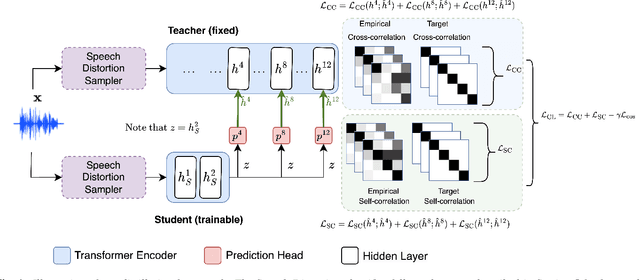
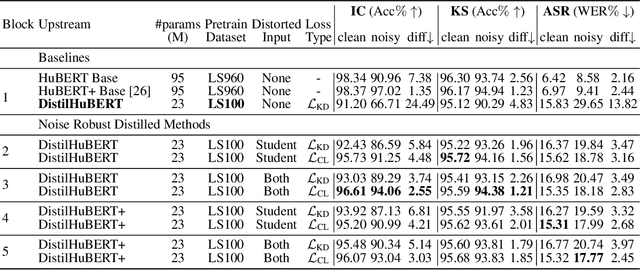

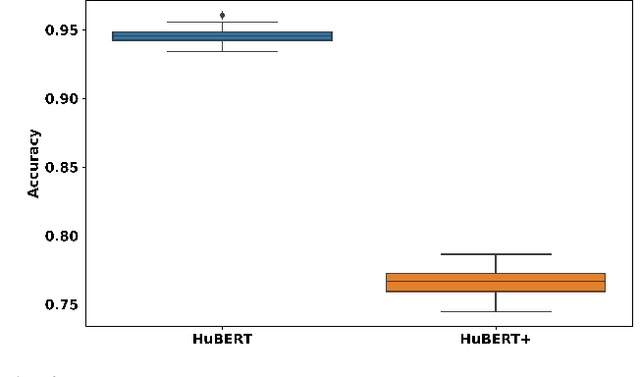
Abstract:Compared to large speech foundation models, small distilled models exhibit degraded noise robustness. The student's robustness can be improved by introducing noise at the inputs during pre-training. Despite this, using the standard distillation loss still yields a student with degraded performance. Thus, this paper proposes improving student robustness via distillation with correlation metrics. Teacher behavior is learned by maximizing the teacher and student cross-correlation matrix between their representations towards identity. Noise robustness is encouraged via the student's self-correlation minimization. The proposed method is agnostic of the teacher model and consistently outperforms the previous approach. This work also proposes an heuristic to weigh the importance of the two correlation terms automatically. Experiments show consistently better clean and noise generalization on Intent Classification, Keyword Spotting, and Automatic Speech Recognition tasks on SUPERB Challenge.
Multiple output samples for each input in a single-output Gaussian process
Jun 05, 2023
Abstract:The standard Gaussian Process (GP) only considers a single output sample per input in the training set. Datasets for subjective tasks, such as spoken language assessment, may be annotated with output labels from multiple human raters per input. This paper proposes to generalise the GP to allow for these multiple output samples in the training set, and thus make use of available output uncertainty information. This differs from a multi-output GP, as all output samples are from the same task here. The output density function is formulated to be the joint likelihood of observing all output samples, and latent variables are not repeated to reduce computation cost. The test set predictions are inferred similarly to a standard GP, with a difference being in the optimised hyper-parameters. This is evaluated on speechocean762, showing that it allows the GP to compute a test set output distribution that is more similar to the collection of reference outputs from the multiple human raters.
Diarisation using location tracking with agglomerative clustering
Sep 24, 2021


Abstract:Previous works have shown that spatial location information can be complementary to speaker embeddings for a speaker diarisation task. However, the models used often assume that speakers are fairly stationary throughout a meeting. This paper proposes to relax this assumption, by explicitly modelling the movements of speakers within an Agglomerative Hierarchical Clustering (AHC) diarisation framework. Kalman filters, which track the locations of speakers, are used to compute log-likelihood ratios that contribute to the cluster affinity computations for the AHC merging and stopping decisions. Experiments show that the proposed approach is able to yield improvements on a Microsoft rich meeting transcription task, compared to methods that do not use location information or that make stationarity assumptions.
Joint speaker diarisation and tracking in switching state-space model
Sep 23, 2021



Abstract:Speakers may move around while diarisation is being performed. When a microphone array is used, the instantaneous locations of where the sounds originated from can be estimated, and previous investigations have shown that such information can be complementary to speaker embeddings in the diarisation task. However, these approaches often assume that speakers are fairly stationary throughout a meeting. This paper relaxes this assumption, by proposing to explicitly track the movements of speakers while jointly performing diarisation within a unified model. A state-space model is proposed, where the hidden state expresses the identity of the current active speaker and the predicted locations of all speakers. The model is implemented as a particle filter. Experiments on a Microsoft rich meeting transcription task show that the proposed joint location tracking and diarisation approach is able to perform comparably with other methods that use location information.
High-Accuracy and Low-Latency Speech Recognition with Two-Head Contextual Layer Trajectory LSTM Model
Mar 17, 2020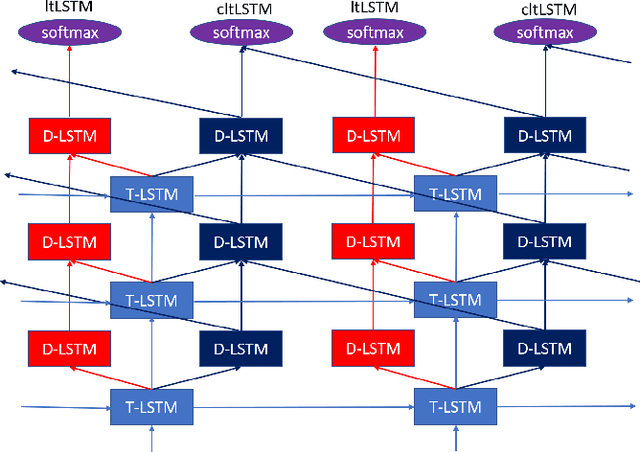

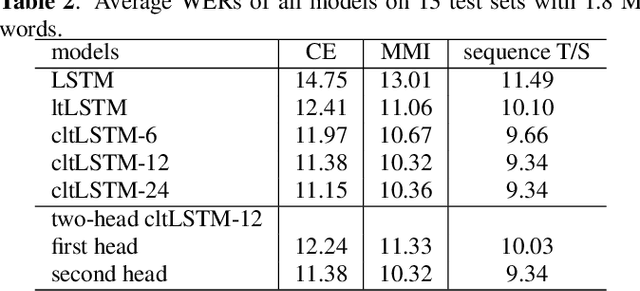

Abstract:While the community keeps promoting end-to-end models over conventional hybrid models, which usually are long short-term memory (LSTM) models trained with a cross entropy criterion followed by a sequence discriminative training criterion, we argue that such conventional hybrid models can still be significantly improved. In this paper, we detail our recent efforts to improve conventional hybrid LSTM acoustic models for high-accuracy and low-latency automatic speech recognition. To achieve high accuracy, we use a contextual layer trajectory LSTM (cltLSTM), which decouples the temporal modeling and target classification tasks, and incorporates future context frames to get more information for accurate acoustic modeling. We further improve the training strategy with sequence-level teacher-student learning. To obtain low latency, we design a two-head cltLSTM, in which one head has zero latency and the other head has a small latency, compared to an LSTM. When trained with Microsoft's 65 thousand hours of anonymized training data and evaluated with test sets with 1.8 million words, the proposed two-head cltLSTM model with the proposed training strategy yields a 28.2\% relative WER reduction over the conventional LSTM acoustic model, with a similar perceived latency.
 Add to Chrome
Add to Chrome Add to Firefox
Add to Firefox Add to Edge
Add to Edge